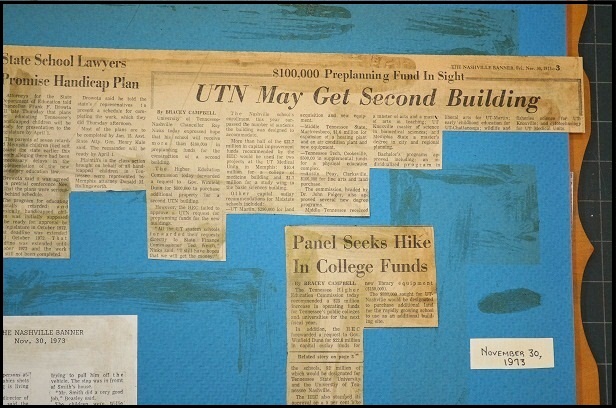 By Kim Norman, Conservator, Emory University Libraries Preservation Office
By Kim Norman, Conservator, Emory University Libraries Preservation Office
Rare scrapbooks that document African American life in the United States from 1890-1975 are being preserved with support through a “Save America’s Treasures” (SAT) grant. The project is a collaborative effort with the Emory University Preservation Office, Digitization Center, and the Manuscript, Archives, and Rare Book Library (MARBL). The SAT grant is awarded through the Department of Interior and the National Park Service, in collaboration with the National Endowment for the Arts (NEA), National Endowment for the Humanities (NEH), and the Institute of Museum and Library Services (IMLS).

Churchwell scrapbook title page
Journalist Robert Churchwell (1917-2009) was born and raised in Clifton, Tennessee. During World War II, he served in both the Pacific and European theaters. During tours of duty overseas, Churchwell’s interest in writing increased, both professionally and steadily. After an honorable discharge from the Army, Churchwell enrolled at Fisk University and graduated in 1949 with an English degree.
With writing experience and interest in journalism, Churchwell joined the Nashville Banner newspaper in 1950. The Banner previously had an all-white staff and hired him in order to increase circulation in the African American community. Churchwell accepted that position, because the traditionally black newspaper in Nashville had no available paying jobs in 1950. For his staff assignment, he covered many civil rights-related events in the area and was assigned to the education beat for over two decades.
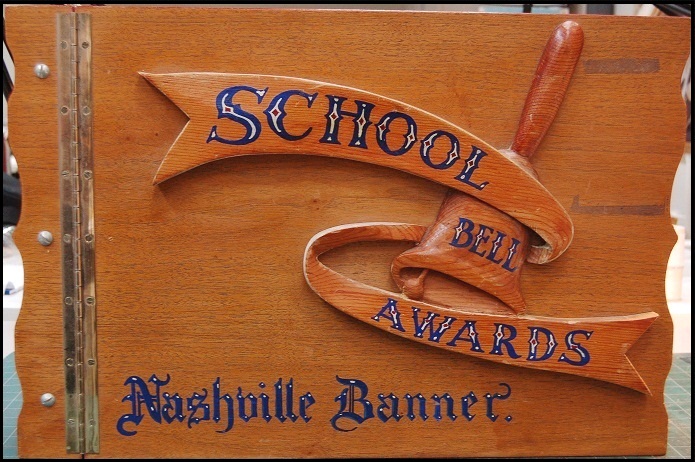
Scrapbook 3-D wooden cover
In 1951, Churchwell married Mary Elizabeth Buckingham, and they had five children. Throughout his journalism career, he received many awards and honors for his contributions to the field. He retired from the Banner in September 1981 after thirty-one years of service. In 1994, Churchwell was inducted into the National Association of Black Journalists Hall of Fame. That same year, he received a Presidential citation from the National Association for Equal Opportunity in Higher Education. Churchwell remained an active writer until his death in 2009.
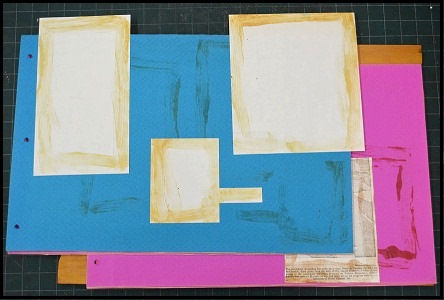
One of Churchwell’s two scrapbooks in the MARBL collection was presented to him in 1974 by the Tennessee Education Association. It contains copies of the Nashville Banner newpaper articles that Churchwell wrote during 1973, articles entitled School Impressions. In honor of his important contributions, Churchwell was recognized with School Bell Awards, signifying excellence in education coverage as a journalist.
This scrapbook structure is different than any of the others in the Emory collection. The hand-tooled, wooden covers are thick, heavy, and three-dimensional. The multi-colored pages were bolted together with the covers as a make-shift post binding structure, using long screws secured by nuts at the back. The front and back covers are able to flex only at the full-length piano hinges. Each color band of pages represents a month in 1973, and each month is separated by a creative divider page. Originally, plastic file folder tabs were attached for easier month location, though many are now lost. Since 1974, the rubber cement adhesive that once attached articles and ephemera to each construction paper support page has failed. Most scrapbook items were loosened from the support pages, and many had slipped out of sight into the spine area.
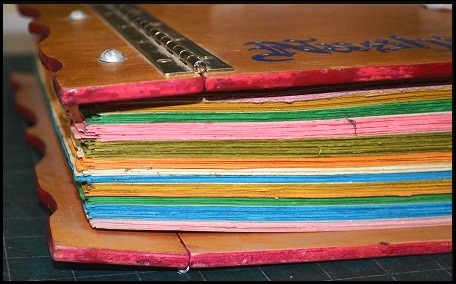
Spine and foot view of scrapbook binding
In order to treat and repair all of the individual items that had become detached from the pages, the screws had to be loosened and the wooden covers removed, freeing the text block. The same process of opening the binding may be necessary for scanning this scrapbook, as the nature of the boards and papers makes it inflexible. On each page was a stain map of adhesive residue, making it obvious where most detached items belonged. The overall weight of this scrapbook succeeded in holding most items securely, though use of the scrapbook was necessarily restricted by MARBL.
One page at a time, items were returned to the original page position and reattached using wheat starch paste. Pages needed to dry individually under heavy weight, considerably slowing the treatment process. Another characteristic of these specific materials was the solubility of the bright page colors and any added handwriting. That, combined with water in the wheat paste, made for some surprising and tricky treatments. Thin paste made the pages buckle and the color leach, requiring very dry paste and quicker working time.
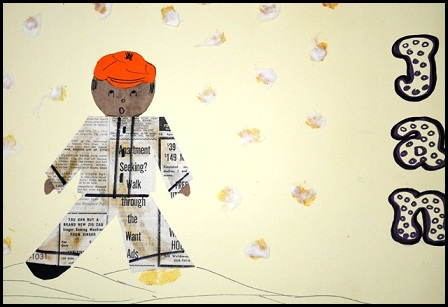
January divider page
It became important to determine our priorities of treatment within this collection. The scrapbooks were separated into three main categories (A, B, C), based upon immediate preservation needs and the level of patron use. Churchwell’s scrapbook is part of group A to be conserved and scanned, needing more treatment and most often requested by patrons.
At first glance, this scrapbook seemed to have the most predictable and straightforward needs, a course of treatment that would be simple and effective; however, this treatment took the longest time of all conserved scrapbooks in group A, about 62 hours. The process was slow, and the materials were high-maintenance. Though not as damaged as some of the other small scrapbooks, it required much more time, effort, and care in the end.
Video interviews with Robert Churchwell, made possible by the National Visionary Leadership Project, can be found through the following link–http://www.visionaryproject.org/churchwellrobert/. In this series of ten short videos, Churchwell discusses his family, military experience, civil rights, and journalism career.

